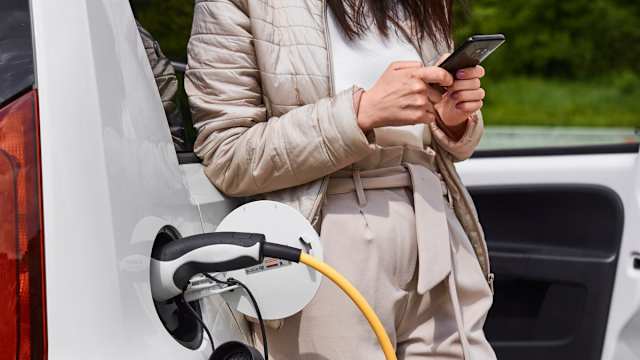
Advertise your car on two platforms at the same time with no extra hassle
Advertise once – benefit twice: automatically advertise your car on autoscout24.ch and comparis.ch at the same time for no extra cost.
Selling your car: 10 tips for successWhy sell your car via Comparis?

Reach more buyers
Your ad will appear on comparis.ch, as well as on our partner site autoscout24.ch.

Quick and easy
Create your ad easily and effectively in just a few steps.

Secure and flexible
Pay securely and directly by Twint, credit card or invoice.

Reach more buyers
Your ad will appear on comparis.ch, as well as on our partner site autoscout24.ch.

Quick and easy
Create your ad easily and effectively in just a few steps.

Secure and flexible
Pay securely and directly by Twint, credit card or invoice.
Overview of all conditions
Here’s how it works: you advertise your vehicle with our partner Autoscout24.
Your ad will also appear on comparis.ch at no extra cost.
Autoscout24 is responsible for processing payments and checking your ad. You can pay by Twint, credit card or invoice (with a CHF 9 processing fee).
Contact: 031 744 17 37 | helpdesk@autoscout24.ch | Mon-Fri: 08.00 a.m. to 05.00 p.m.
| Term | Basic | Plus | Premium | Unlimited |
|---|---|---|---|---|
| 14 days | from CHF 59 | from CHF 99 | from CHF 149 | - |
| 30 days | from CHF 99 | from CHF 149 | from CHF 249 | - |
| 60 days | from CHF 169 | from CHF 249 | CHF 399 | - |
| Unlimited | - | - | - | from CHF 299 |
Selling your car: 10 tips for success
To sell your car successfully, it's important to choose the right time, prepare the sale properly and have some good selling points. Comparis helps you increase your chances and shares 10 valuable tips on achieving a sale.
The first thing to decide on is when to sell. How high is demand for your vehicle in a particular season? If you are selling a convertible, it’s better to wait until spring. If possible, avoid the summer holidays or the January slump. This is because sale prices will fluctuate to reflect lower demand.
Are any repairs needed?
Repairing any smaller dents, paintwork or upholstery damage can pay off. A simple SMART or spot repair can work wonders on the appearance of your vehicle. Depending on your cover, you may be able to claim the cost of the repair from your car insurer. However, find out first how much the repairs will cost and how much your deductible is, if you have one.
When was the last technical vehicle inspection?
Is your vehicle over 10 years old and was the last official vehicle inspection more than a year ago? If so, you must arrange for a professional to look at the car before it changes owner. A voluntary inspection prior to selling can also be worthwhile for newer vehicles. Used cars that have undergone a recent inspection are generally more popular with buyers.
Is the car still under warranty?
Has the manufacturer’s warranty expired recently? Find out whether you can take out an extended warranty. This can speed up your sale, particularly with more expensive vehicles. In this case, the manufacturer’s products are the best choice. They usually contain the same benefits as the original warranty. If you choose a third-party provider, check the cover and whether any excess or deductible applies. The cost of an extended warranty varies according to provider and model. Contact your nearest dealer for more information.
Our tip: evaluate the costs and benefits before carrying out any repairs, booking a vehicle inspection or taking out an extended warranty. Is the financial outlay worth the additional benefit?
The best way to work out a selling price is to take a look at the vehicle registration document. You will need the following information to determine a vehicle’s value:
Date of first registration
Mileage
Make
Model
Type approval (vehicle registration document item 24; if make and model cannot be determined exactly)
How can I decide on the selling price myself?
Alternatively, you can establish the market value of your car yourself. The advantage of this is you become familiar with the competition. The downside is that the process takes longer.
This is how it works: look for ads for similar vehicles on an online car marketplace. Concentrate on the following criteria:
Make
Model
First registration (year)
Fuel (petrol, diesel, bioethanol, gas, hybrid, electric, hydrogen)
Transmission (manual or automatic)
Drive (all-wheel, rear-wheel, front-wheel)
Mileage is also a factor but shouldn’t be filtered for the first search, otherwise you’ll obtain too few results. On the basis of the ads displayed, you can establish a price range within which you can set your price.
Good to know: if you want to sell the car as quickly as possible, set a lower price.
First impressions count - the same applies when selling a car. The quantity of cars for sale is huge and it’s not easy to stand out from the crowd. High-quality pictures are therefore key to a successful sale. Observe the following points when photographing the vehicle:
Ensure that the car is clean. If possible, wash it beforehand.
Take photos from all possible angles.
Include photos of the interior.
Remove any snow or leaves from the car if necessary.
Our tip: choose a neutral environment, such as an empty car park, as a background for your photos to avoid unnecessary distractions.
If you have experience in making videos, you can also include a YouTube video of the car. It’s important that the car in the video is the one that you are actually selling. Ensure that the content is of good quality.
In your ad, describe the car as comprehensively and accurately as possible. Use the vehicle registration document and your current contract as a guide. As well as the compulsory information (make, colour, first registration, price, model and body type), the following details will also have an impact on the sale:
Details of equipment and accessories (standard and optional)
Details of the service history: how often has the vehicle been serviced?
Is the vehicle still under warranty and for how long?
Are there any free services still available?
Has a vehicle inspection recently been completed?
Mention any faults or defects as well as the positive features. This will help establish a relationship of trust before a possible meeting. Important: ensure that all details are truthful. If a car has been in an accident and this isn’t clearly stated, the buyer can withdraw from the sale.
Good to know: if you advertise the vehicle on the basis of its type approval, details such as standard equipment will automatically be included.
How much does it cost to list a property?
The cost of advertising with the partnership of comparis.ch and autoscout24.ch depends on how long you wish the ad to be displayed. You can pay by credit card or invoice (the latter incurs a processing fee of 9 francs). You create the ad directly on our partner’s website.
If you don’t want to spend any money, you can advertise your vehicle on other channels. However, you can expect it to take a bit longer to find a suitable buyer. A sign placed in your car parked on the street is one way of drawing the attention of passers-by to your sale. Free classified ads (online or offline) or social media posts are alternative options.
Publishing the ad does not mean that your work is done! If no one has contacted you after a week (or ten days maximum), you should reconsider your offer. Does your ad contain enough selling points? Is the quality of the photos high enough? If you cannot answer “yes” to these questions, considering adjusting the price.
Our tip: car buyers usually sort their search results from lowest to highest price. Setting your selling price so that it appears on the first page of a detailed search increases your chances of achieving a sale.
Before you meet a potential buyer, think about what is attractive about your vehicle. Preparing properly for this meeting can make a big difference to your chances of a sale. Possible selling points include:
The car has only had one owner
The car was driven primarily on motorways
The car was serviced at the required intervals
No one smoked in the car
It has a timeless design
No animals (e.g. dogs) were transported in the car
Note: consider how far you are prepared to reduce the price before negotiating.
Which documents are required?
Make sure you have all the necessary paperwork ready.
Vehicle registration document
Service log book
Results of the most recent vehicle inspection
Vehicle owner’s manual
Emissions documents
In addition, have invoices for major repairs such as new brakes and tyres to hand. Receipts for extra accessories, tuning and maintenance work may also be useful.
Necessary preparations before the meeting
Wash the car again before the appointment. Pay attention to details such as tyres, wheel rims and the condition of the bonnet. Potential buyers generally inspect these parts more closely. Remove anything that does not belong to the car. Check levels of liquids such as oil, coolant and windscreen washer fluid. Finish by checking the tyre pressure and lights.
Allow sufficient time for the appointment, including a test drive (around 1.5 hours). Important: ask the potential buyer for ID and their driving licence. Ideally, make a note of the ID number. Accompany the potential buyer on the test drive if possible. You can then comment on the handling and performance during the drive. For safety reasons, don’t arrange to meet in an unusual place, such as a lay-by or motorway service station, and take someone else along with you, if possible.
Our tip: if you have one, bring the sale agreement to the test drive appointment. It’s best if the buyer signs it there and then. Important: don't sign any agreements provided by the buyer. If the buyer puts you under pressure, end the negotiations. You set the rules.
You are advised to enter into a contract when selling a car, even if the transaction is between friends. The contract should contain details of both parties and information about the vehicle. Avoid statements about whether the vehicle has been in an accident unless you are completely sure. If you mark the vehicle as “accident-free” on the sale agreement, this means you take responsibility for any accident damage caused by the previous owner and will have to accept any resulting consequences. In other words, the buyer can withdraw from the sale.
Cash payment is the most reliable method. You should only accept a down payment if the outstanding amount will be paid at the vehicle handover. You should only hand over the vehicle when you have received the full payment. Obtain a receipt for all the documents and keys you hand over.
It’s a good idea to deregister the vehicle yourself. You can do this at the Road Traffic Office or by post. Once the vehicle registration document has been cancelled, the car may remain on the road until midnight the same day.
Never hand over a vehicle that is still registered in your name. This could cause you trouble if the future owner doesn’t reregister the vehicle in their name. What’s more, you will pay tax, insurance and fines as long as the vehicle is in your name.
Good to know: remember to notify your insurance company of the vehicle’s sale. It’s best to cancel the agreement officially. The insurance company will then reimburse part of the premium amount you have already paid.




